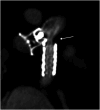Case Report: Transcatheter interventional procedure to innominate vein turn-down procedure for failing fontan circulation
- PMID: 38379912
- PMCID: PMC10876887
- DOI: 10.3389/fped.2024.1341443
Case Report: Transcatheter interventional procedure to innominate vein turn-down procedure for failing fontan circulation
Abstract
Fontan physiology creates a chronic state of decreased cardiac output and systemic venous congestion, leading to liver cirrhosis/malignancy, protein-losing enteropathy, chylothorax, or plastic bronchitis. Creating a fenestration improves cardiac output and relieves some venous congestion. The anatomic connection of the thoracic duct to the subclavian-jugular vein junction exposes the lymphatic system to systemic venous hypertension and could induce plastic bronchitis. To address this complication, two techniques have been developed. A surgical method that decompresses the thoracic duct by diverting the innominate vein to the atrium, and a percutaneous endovascular procedure that uses a covered stent to create an extravascular connection between the innominate vein and the left atrium. We report a novel variant transcatheter intervention of the innominate vein turn-down procedure without creating an extravascular connection in a 39-month-old patient with failing Fontan circulation complicated by plastic bronchitis and a 2-year post-intervention follow-up.
Keywords: case report; failing fontan; hypoplastic left heart syndrome; modified fenestration; plastic bronchitis; transcatheter interventional procedure.
© 2024 Schaffner, Perez, Duran, Pretre and Di Bernardo.
Conflict of interest statement
The authors declare that the research was conducted in the absence of any commercial or financial relationships that could be construed as a potential conflict of interest. The author(s) declared that they were an editorial board member of Frontiers, at the time of submission. This had no impact on the peer review process and the final decision.
Figures




Similar articles
-
Innominate Vein Turn-down Procedure for Failing Fontan Circulation.Semin Thorac Cardiovasc Surg Pediatr Card Surg Annu. 2020;23:34-40. doi: 10.1053/j.pcsu.2020.01.002. Semin Thorac Cardiovasc Surg Pediatr Card Surg Annu. 2020. PMID: 32354545
-
Transcatheter Thoracic Duct Decompression for Multicompartment Lymphatic Failure After Fontan Palliation.Circ Cardiovasc Interv. 2022 Jul;15(7):e011733. doi: 10.1161/CIRCINTERVENTIONS.121.011733. Epub 2022 Jun 16. Circ Cardiovasc Interv. 2022. PMID: 35708032
-
Anesthetic challenges in patients with multicompartmental lymphatic failure after Fontan palliation undergoing transcatheter thoracic duct decompression.Paediatr Anaesth. 2024 Jul;34(7):597-601. doi: 10.1111/pan.14891. Epub 2024 Apr 23. Paediatr Anaesth. 2024. PMID: 38651655
-
Current diagnostic and therapeutic strategies for the management of lymphatic insufficiency in patients with hypoplastic left heart syndrome.Front Pediatr. 2023 Feb 24;11:1058567. doi: 10.3389/fped.2023.1058567. eCollection 2023. Front Pediatr. 2023. PMID: 36911024 Free PMC article. Review.
-
Transcatheter interventions in patients with a Fontan circulation: Current practice and future developments.Front Pediatr. 2022 Aug 30;10:965989. doi: 10.3389/fped.2022.965989. eCollection 2022. Front Pediatr. 2022. PMID: 36110107 Free PMC article. Review.
Cited by
-
Lymphatic Disorder Management in Pediatric Patients With Congenital Heart Disease in European Pediatric Cardiology Centers: Current Status, Disparities, and Future Considerations.J Am Heart Assoc. 2024 Nov 19;13(22):e036597. doi: 10.1161/JAHA.124.036597. Epub 2024 Nov 7. J Am Heart Assoc. 2024. PMID: 39508150 Free PMC article.
References
Publication types
LinkOut - more resources
Full Text Sources

